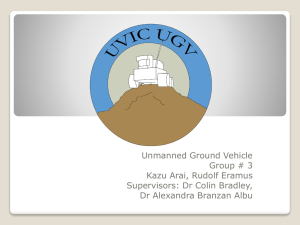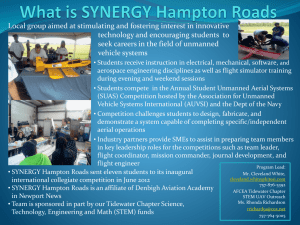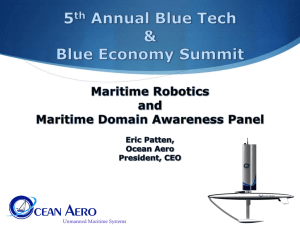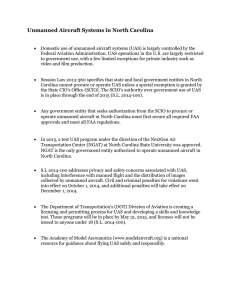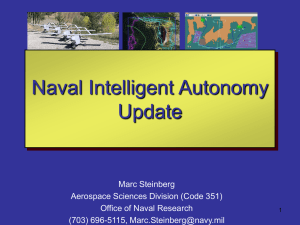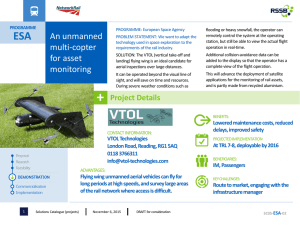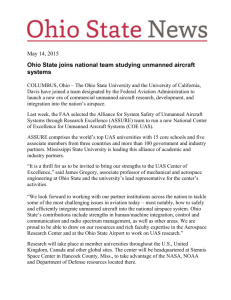Contents FEATURED ARTICLE From Technical to Ethical...From Concept Generation to Experimentation
advertisement
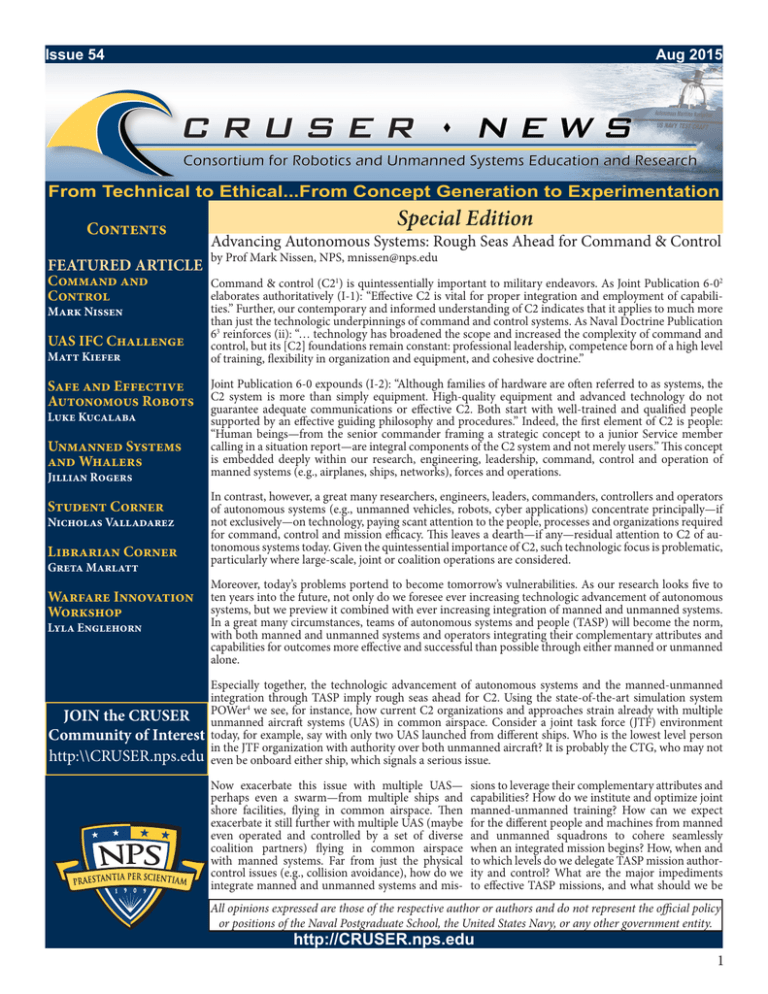
Issue 54 Aug 2015 From Technical to Ethical...From Concept Generation to Experimentation Contents FEATURED ARTICLE Command and Control Mark Nissen UAS IFC Challenge Matt Kiefer Safe and Effective Autonomous Robots Luke Kucalaba Unmanned Systems and Whalers Jillian Rogers Student Corner Nicholas Valladarez Librarian Corner Greta Marlatt Warfare Innovation Workshop Lyla Englehorn JOIN the CRUSER Community of Interest http:\\CRUSER.nps.edu Special Edition Advancing Autonomous Systems: Rough Seas Ahead for Command & Control by Prof Mark Nissen, NPS, mnissen@nps.edu Command & control (C21) is quintessentially important to military endeavors. As Joint Publication 6-02 elaborates authoritatively (I-1): “Effective C2 is vital for proper integration and employment of capabilities.” Further, our contemporary and informed understanding of C2 indicates that it applies to much more than just the technologic underpinnings of command and control systems. As Naval Doctrine Publication 63 reinforces (ii): “… technology has broadened the scope and increased the complexity of command and control, but its [C2] foundations remain constant: professional leadership, competence born of a high level of training, flexibility in organization and equipment, and cohesive doctrine.” Joint Publication 6-0 expounds (I-2): “Although families of hardware are often referred to as systems, the C2 system is more than simply equipment. High-quality equipment and advanced technology do not guarantee adequate communications or effective C2. Both start with well-trained and qualified people supported by an effective guiding philosophy and procedures.” Indeed, the first element of C2 is people: “Human beings—from the senior commander framing a strategic concept to a junior Service member calling in a situation report—are integral components of the C2 system and not merely users.” This concept is embedded deeply within our research, engineering, leadership, command, control and operation of manned systems (e.g., airplanes, ships, networks), forces and operations. In contrast, however, a great many researchers, engineers, leaders, commanders, controllers and operators of autonomous systems (e.g., unmanned vehicles, robots, cyber applications) concentrate principally—if not exclusively—on technology, paying scant attention to the people, processes and organizations required for command, control and mission efficacy. This leaves a dearth—if any—residual attention to C2 of autonomous systems today. Given the quintessential importance of C2, such technologic focus is problematic, particularly where large-scale, joint or coalition operations are considered. Moreover, today’s problems portend to become tomorrow’s vulnerabilities. As our research looks five to ten years into the future, not only do we foresee ever increasing technologic advancement of autonomous systems, but we preview it combined with ever increasing integration of manned and unmanned systems. In a great many circumstances, teams of autonomous systems and people (TASP) will become the norm, with both manned and unmanned systems and operators integrating their complementary attributes and capabilities for outcomes more effective and successful than possible through either manned or unmanned alone. Especially together, the technologic advancement of autonomous systems and the manned-unmanned integration through TASP imply rough seas ahead for C2. Using the state-of-the-art simulation system POWer4 we see, for instance, how current C2 organizations and approaches strain already with multiple unmanned aircraft systems (UAS) in common airspace. Consider a joint task force (JTF) environment today, for example, say with only two UAS launched from different ships. Who is the lowest level person in the JTF organization with authority over both unmanned aircraft? It is probably the CTG, who may not even be onboard either ship, which signals a serious issue. Now exacerbate this issue with multiple UAS— perhaps even a swarm—from multiple ships and shore facilities, flying in common airspace. Then exacerbate it still further with multiple UAS (maybe even operated and controlled by a set of diverse coalition partners) flying in common airspace with manned systems. Far from just the physical control issues (e.g., collision avoidance), how do we integrate manned and unmanned systems and mis- sions to leverage their complementary attributes and capabilities? How do we institute and optimize joint manned-unmanned training? How can we expect for the different people and machines from manned and unmanned squadrons to cohere seamlessly when an integrated mission begins? How, when and to which levels do we delegate TASP mission authority and control? What are the major impediments to effective TASP missions, and what should we be All opinions expressed are those of the respective author or authors and do not represent the official policy or positions of the Naval Postgraduate School, the United States Navy, or any other government entity. http://CRUSER.nps.edu 1 Issue 54 Aug 2015 doing now to prepare for and overcome them? These are all important integration, and approaches to C2 organization. We compare perforC2 questions that we will need to answer well in advance of TASP mance metrics across an array of measures including time for effective missions becoming commonplace in the coming half decade. mission completion, mission errors and corresponding rework, C2 communication and coordination load, along with mission cost, risk Through CRUSER sponsorship and guidance, our POWer5 research and others. is beginning to answer some of these questions. Examining UAS in use today within the CTG mission environment, as an important We also examine UAS across a wide range of technology degrees: from place to begin, we’ve identified many troublesome C2 problems al- operational UAS in the current inventory, through those undergoing ready. For one instance, the C2 organization reflects a tall, functional test and evaluation today, to future systems envisioned with perforhierarchy, with considerable centralization, substantial formalization mance levels matching—and even surpassing—those achievable and frequent staff rotation. This makes for relatively long informa- only through manned systems today. This enables us to examine a tion flows and decision chains, coupled with perennial battles against correspondingly wide array of C2 organizations and approaches, misknowledge loss from personnel turnover and challenges with cross- sion scenarios, technology degrees and levels of manned-unmanned functional (and even more so with joint and coalition) interaction. mission integration, from those taking place in current operations Many organization experts would argue that the correspondingly long through counterparts likely five to ten years hence. decision chains, information flows and staffing turbulence militate against efficient—or even effective—C2. Further, POWer supports computational experiments that allow us to examine this wide array in a very systematic and precise manner. As another instance, the formalization inherent within this C2 orga- Changing the level of only one variable at a time—or analyzing suites nization reflects strong dependence upon written standards, rules and of level changes across multiple variables simultaneously—we can procedures (e.g., SOPs, TTPs, PPRs, work standards, job qualifica- ascribe resulting performance differences specifically and unambigutions). However, the continuing technologic advance and integration ously to each such level change, and we can explain precisely how each of UAS suggests that formalization through written documents may variable—independent, dependent or control—is defined, operationhave a hard time keeping up with rapid and local knowledge onboard alized and manipulated. This supports exceedingly high reliability and various ships and across diverse crews. Although this is a knowledge internal validity through our experiments. management problem, as with the long decision chains, information flows and staffing turbulence noted above, many organization Moreover, the cost of computational experiments is exceptionally experts would argue here that the correspondingly high dependence low, and the speed is exceptionally high, so we can assess hundreds or upon standardization and written documentation militate against thousands—even millions—of different scenarios in short periods of efficient—or even effective—C2. time, with no risk of losing valuable equipment or people (e.g., as can occur through lab and field experiments) in the process. This capabilMoreover—and perhaps somewhat counter intuitively—for many ity equips us to peer well into the future, to make informed decisions, years to come, unmanned missions will likely require more planning, and to take dominating actions, not only regarding which alternate monitoring, intervening and like control activities than their manned futures to select, but also regarding how to achieve each future in a counterparts. Hence greater numbers of C2 staff—or more skilled competitively advantageous way. and experienced staff members—will be required for unmanned than for manned missions, and such missions will be expected to In light of the issues identified above, we’re looking in particular at take more time, suffer from more mistakes, and generally tax the C2 how to address the long decision chains, information flows and stafforganization more greatly. (Overall, many unmanned missions are ing turbulence that militate against efficient or effective C2 at present, still more economic, but they exact greater demands in terms of C2 and we’re concentrating on managing the kinds of fast-changing local coordination load.) This eventuality will exacerbate for integrated knowledge that challenges even the best efforts in terms of written manned-unmanned events, particularly as we expand across joint and standards, rules and procedures. We’re considering further how to coalition operations. decrease the coordination load on C2 of unmanned systems, and we continue to envision alternate approaches to the integrated recruiting, As a third instance, problematic issues are highly likely to arise training, promotion and performance of manned and unmanned also in terms of different skill levels, lack of common training or operators. co-operational experience, and very low—or no—trust between manned and unmanned aircraft operators. A great many manned and In the near future, we anticipate laying out a list of highly promising, unmanned systems personnel are members of different tribes—with agile approaches to adapting C2 in response to such issues, with a distinct cultures and status—that recruit, train, operate and promote set of milestone markers to signal when each will likely become most separately for the most part. TASP requires manned and unmanned appropriate, and a set of plans for how to effect each of them. The idea mission integration, flying together in common airspace, and relying is to peer sufficiently far into the future so that we can provide leaders, integrally upon one another. Imaging telling a Fleet aviator that he or policy makers and technologists today with the time and guidance she will have an unmanned wingman! needed for them to prepare for and navigate the rough seas ahead. Of course the simple solution is to keep manned and unmanned systems separate: in separate organizations, in separate airspaces, with separate skill sets, with separate procedures. Such simple solution negates the integrative power and efficacy of TASP, however. Where teams of autonomous systems and people can be more effective than either manned or unmanned systems alone, an adversary can potentially become victorious with C2 sufficiently advanced for TASP. This can be the case even where the technology of our manned and unmanned systems is superior. In other words, advances in C2 may trump superior technology. The term C2 as discussed here subsumes and largely replaces the myriad extension of “Cs” (e.g., C3, C3I, C4, C4I, C4ISR, C5I). 2 JP6-0, Joint Publication 6-0: Joint Communication System Washington, DC: Joint Chiefs of Staff (2015). 3 NDP6, Naval Doctrine Publication 6: Naval Command and Control Washington, DC: Department of the Navy (1995). 4 POWer derives from the VDT Group at Stanford and has been tailored and validated to simulate the qualitative and quantitative behaviors of C2 organizations, approaches, personnel and systems. 5 See, for example, Nissen, M.E. and Place, W.D., “Computational Experimentation to Understand C2 for Teams of Autonomous Systems and People,” Technical So where do we go from here? Our ongoing research continues to em- Report NPS-14-007, Naval Postgraduate School, Monterey, CA (December ploy POWer to project and analyze the comparative performance of 2014). different missions, technology degrees, levels of manned-unmanned 2 1 Consortium for Robotics and Unmanned Systems Education and Research Issue 54 Director’s Corner Aug 2015 Steve Iatrou, CRUSER Director of Strategic Communication From Technical-to-Ethical and this month we cover everything in between. Dr. Nissen’s Featrured article on the complexities of C2 in the modern world captures the challenges of integrating humans and autonomous systems. Although the issues may seem insurmountable Dr. Nissen’s research demonstrates that the challenge is being met. Similarly, LT Kiefer is tackling the antiquated policy issues at NAVAIR in an effort to bring their policies into the 21st century. Keeping with the theme of policies and processes LT Kucalaba explores the balance between advances in technology and human safety. Perhaps in a nod to Dr. Nissen’s call for better C2 we have an article on a cooperative effort between researchers at the University of Alaska Fairbanks and the local community to use hexacopters to find the best path through the ice; it’s not a major military operation but certainly required some level of C2 to coordinate the mission. And not to leave out the purely technical portion of CRUSER LT Valladaraz offers an overview of his research into precise underwater vehicle control. As you can see there’s something of interest for everyone, and everyone should be interested in all these things. We’re CRUSER, it’s what we do! NPS - NAVAIR UAS IFC Challenge by LT Matt Kiefer, NPS Student, Team Lead of Team KLAW, matthew.kiefer.5@us.af.mil With the proliferation of inexpensive equipment that can be used to make unmanned aerial systems, more and more research institutions can complete more unmanned flying research while spending less money than ever before. Research institutions such as NPS are turning to “off the shelf ” technology to create unmanned flying platforms they can operate on a constrained budget while still completing the full scope of their test objectives. In some cases they will be able to have enhanced capabilities over existing systems. on this research that mostly focused on communication improvements between the two organizations and information sharing to support risk based decisions on the part of AIR 4.0P. While some of these recommendations began to be implemented the Phase II team came online and began to focus on the risk assessments associated with UAS operation and IFCs. Their research led them to discover the Bayesian Belief Network as a risk assessment tool that could possibly satisfy AIR 4.0P’s need for data to be used in airworthiness determinations. They went on to find and test a software tool that As a matter of policy, NAVAIR is charged with establishing could make appropriate airworthiness determinations. and maintaining airworthiness requirements for all Naval aircraft. This includes UASs of all sizes. AIR 4.0P is the compe- Phase III of the project started work just as Phase II was fintency organization charged by NAVAIR to complete this task. ishing. They took the work that Phase II did with the Hugin Put basically, AIR 4.0P will issue airworthiness certification BBN software and then proceeded to adapt it for practicality for a platform through a promulgated NATOPS manual or and present it to two different UAS project teams as well as an Interim Flight Clearance (IFC). Experimental aircraft are AIR 4.0P for their concurrence that this tool and analysis is typically issued IFCs for airworthiness vice a NATOPS man- suitable for the issuance of an IFC. The Phase III team has ual due to the temporary nature of their development. AIR progressed through an iterative process of changing the soft4.0P will typically approve IFCs based on past operational ware tool to achieve the concurrence of these stakeholders. history (failure data) or testing data. The approvers appointed By the time the Phase III project came to an end the team had by AIR4.0P operate in a process where they expect to see this a risk analysis tool their stakeholders could accept. This conkind or data with an IFC request. currence means that the software tool can move on to be used by NPS research project teams. From here it is expected that A problem has arisen where research programs intend to use the software tool created by Phase III will be refined into user commercially derived systems to make a UAS but when they friendly application that TAEs and project teams can use easapproach AIR 4.0P they do not have the required data to ful- ily to complete risk assessments for their aircraft and quickly fill the needs for the review. The reality is that this sort of data gain issuance of an IFC. This could be done by a company does not exist and the research project may spend so much contracted by NPS or by another student team. time trying to produce data to satisfy the airworthiness authority, that they risk failing to meet their research schedule These improvements are critical to the forward progress of and goals. The NPS UAS IFC Challenge was created to re- the use of UASs within NPS and NAVAIR. The work done by search and address this situation. The challenge project was the IFC Challenge teams has gone a long way toward creatsplit into three phases to be worked by NPS Systems Engi- ing a smooth and standardized process for ensuring the airneering student teams as their capstone projects. worthiness of UAS platforms used in research. Relatively little work is left to be done to complete this task that will remove Phase I looked at the state of UAS projects at NPS and the current barriers and allow research teams to focus on their AIR 4.0P IFC process. They made recommendations based research and not on the airworthiness process. Consortium for Robotics and Unmanned Systems Education and Research 3 Issue 54 Roadmap to Safe and Effective Autonomous Robots Aug 2015 by Luke Kucalaba, Principal Research Scientist, Battelle Memorial Institute A key challenge exists today in the acceptance and mass deployment of autonomous mobile robots into society. The government has an obligation to the public to ensure that autonomous robots are safe. The spatial freedom exercised by mobile robots presents a real concern to public safety, especially for robots outfitted with powerful manipulators or entrusted with transporting human occupants. Traditional methods involve running extensive live tests in a closed lab environment using real prototype hardware, an expensive and time consuming process that yields sparse results at best considering the vastness of complexity that exists in the real world. Battelle is exploring a novel approach to accelerate progress towards a viable solution for a more robust qualification process. Using advanced 3d modeling and simulation techniques, the autonomy system under test can be immersed into a 3d computer simulation environment. Figure 1. Virtual Camera Sensors* The hardware sensors of the robot are first modeled through a sensor characterization process, where the bias and error inherent in the sensors is profiled for accurate reproduction in simulation. Virtual sensors such as the stereoscopic camera shown in Figure 1 are immersed into a virtual environment, which provides sufficient stimulation for the autonomy software into accepting the virtual world as the real world. This triggers the autonomy system to exercise the same sensor data fusion, intelligence gathering, and decision-making algorithms that would normally operate in the real world. Once the autonomy software is immersed into the virtual environment, the benefits of adopting a simulation approach for R&D, T&E, and V&V begin to become evident. Economies of scale can be utilized by cloning the simulation, which requires merely allocating more computing resources. Not only is it less expensive to establish new virtual testbeds, but also the virtual environment is a fully controlled environment; all typically external environmental conditions such as weather and lighting are controlled in the virtual environment and are exactly repeatable across experiment runs (Figure 2). In order to qualify autonomy software as safe and effective for incorporation into society at large, the virtual simulation testbed must provide the capability to simulate large quantities of independent virtual agents that can potentially interact with the autonomous system unFigure 2. Virtual Autonomy Testbed* der test. Agent-based modeling techniques have grown in maturity and popularity in recent years to provide this type of massive simulation of actor systems, for instance to model swarming behaviors or unpredictable crowd movements. Stochastic and even irrational behaviors can be modeled to trigger rare problematic circumstances. Faster than realtime simulations are possible using instrumented simulation clocks. As depicted in Figure 3 below, Battelle is experimenting with the idea of integrating an agent-based logistics engine into their virtual robotics software infrastructure, the Simulation Architecture for Mobile Systems (SAMS), and exploring a federated architecture that supports faster-than-realtime distributed simulations. The virtual autonomy testbed is a roadmap to safe and effective autonomous robots. In a capitalist society with market competition in industry and opposing pressures from government, an organizational conflict of interest exists as to which side plays the role of evaluator for qualification of autonomous systems. Due to the level of technological complexity involved in establishing a virtual autonomy testbed, the government would typically look to industry to provide the solution. However this introduces a conflict of interest situation because a for-profit company would have a fundamental obligation to provide value for its shareholders first, not necessarily keeping the best interests of society at the forefront. An ideal solution is to establish a third-party independent evaluator to develop and manage the technology for the virtual testbed. Figure 3. Battelle’s Simulation Architecture for Mobile Systems (SAMS) For instance Battelle as a not-for-profit charitable trust has a disinterested mission of advancing science and technology for the betterment of humanity. It is these types of impartial and objective institutions that are best suited for the role of independent autonomy evaluator. Until a virtual autonomy testbed is established with defined evaluator role, the roadmap will continue to remain just a roadmap for years to come. * Images of Battelle Virtual Simulation Environment approved for Public Release (Chief of Naval Research, Case #43-226-15) 4 Consortium for Robotics and Unmanned Systems Education and Research Issue 54 Unmanned Aircraft Scouts Ice Conditions for Whalers Aug 2015 University of Alaska Fairbanks, Barbara Johnson, bjohnson@gi.alaska.edu originally published at: http://www.thearcticsounder.com/ article/1522unmanned_aircraft_scouts_ice_conditions_for Before spring whaling (marine mammal huntering) can even start up on the North Slope, crews and other community members chip away at the sea ice to make miles-long trails to open water, and hopefully, to whales. The process is done with hand tools — mostly ice picks — taking days or weeks, and is very labor intensive. So when researchers at the University of Alaska Fairbanks offered to fly a small, unmanned aircraft over the ice in hopes of finding the safest, most efficient routes to open leads, whaling captains in Barrow were all for it. In April, a Ptarmigan — a small hexacopter designed and built by a UAF engineering student — was launched and flown in a grid pattern 400 feet over a section of ice about 2,600 feet by 600 feet. After the flights, a technique called structure from motion whose usee on ice was pioneered at UAF’s Geophysical Institute, the data was used to create an accurate three-dimensional map of the surface. The result was a topographic map of sorts that allowed whalers to take a closer look at ice conditions and find the best routes to open leads and the whales that show up there. The aircraft was not used to locate whales. “This technique is something that’s been pioneered here at UAF, especially in areas like ice and snow,” said Dyre Oliver Dammann, a doctoral student who, along with Eyal Saiet, a staff member for the Alaska Center for Unmanned Aircraft Systems Integration and masters student in remote sensing, came up with idea to map the ice using the hexacopter. The aircraft was designed and built by UAF electrical engineering student Ben Nubar and is particularly useful for brief flights and experimenting with new instruments. For this spring’s season, which is still going strong, these 3D maps were available to crews online and for download onto phones or other devices. “We provided what we call a digital Photo by Oliver Dammann elevation model, that shows where the large ridges are and where the smooth areas are,” Dammann said. “From that, (they) can immediately identify potential risks.” Researchers and scientists at UAF have been working in the Arctic for years studying sea ice, climate, and creatures big and small. Dammann said “Researchers should always aim to give something back to the community,” he said. “We’ve been trying to understand sea ice and dynamics that are relevant for larger aspects such as climate change, but we’re also very interested in conducting research that has a direct implication for people that live there.” Short articles (up to 500 words) for CRUSER News are always welcome submit to: cruser@nps.edu Whalers, or hunters in general, that use the sea ice already know a lot about how the ice be-Photo by Oliver Dammann haves during spring break up and scientists rely on local knowledge when conducting research there. “So we were trying to provide something that they can learn from that they couldn’t otherwise do,” Dammann said. “It’s a really great relationship.” UAF started mapping whaling trails in the ice about seven years ago to help captains and their crews by identifying not only safer routes, but also more efficient routes, thus saving time and money. “Then we approached them about flying an unmanned aircraft over and actually get the topography of the ice ... and they said they were all for that.” April’s flight and the subsequent maps were a test to see how the aircraft worked and what might need to be tweaked to get more useful information for the crews. A GPS unit and a high-quality camera were fixed to the copter, which was flown by an experienced helicopter pilot. This project is a collaborative effort between UAF and the Barrow Whaling Captains Association. In 2007, the sea ice group from UAF installed a radar and a webcam to provide an uninterrupted view of the ice and while these provide important information to both scientists and locals, the view from the side and the resolution at a distance limit their usefulness. Satellite data is also available, but is cost prohibitive. This new method offers higher-quality and more detailed models for the crews to use when scoping out the routes early in the season. It is not uncommon for crews to get stranded on ice that has broken off from landfast ice during wind events or a change in currents. This project might help protect those working out on the ice by identifying more fragile areas. So far, the feedback has been encouraging, said UAF public information officer Sue Mitchell. “They were very pleased with it,” she said of the whaling crews. “They’re looking forward to doing more next year and looking forward to using (an aircraft) that has a longer operating time. “This was a pilot project to see Photo by Oliver Dammann if it would work.” CRUSER Calendar Warfare Innoation Workshop: 21-24 Sept Meeting: Mon 5 Oct 1200-1250 (PDT) details at http://CRUSER.nps.edu 5 Issue 54 STUDENT CORNER Aug 2015 Student: LT Nicholas D. Valladarez, USN Title: An Adaptive Approach for Precise Underwater Vehicle Control in Combined Robot-Diver Operations Curriculum: Mechanical and Aerospace Engineering Link to Completed Thesis: https://calhoun.nps.edu/handle/10945/45268 Abstract: Joint robot-human operations potentially increase the efficiency, effectiveness and safety of the tasks they perform. The utilization of an autonomous underwater vehicle (AUV) as a robotic diver’s assistant demands joint, dynamic operations involving precise physical interactions between an AUV, human divers, and the environment, which, in turn, requires a robust, accurate control system. A robot acting as a dive assistant would perform tasks such as tool carrying, worksite illumination, or other general assistance jobs that a dive buddy might perform. Such precise control of the AUV normally requires accurate knowledge of the vehicle’s dynamics; however, this high level of accuracy is difficult to obtain without the employment of extensive system identification efforts. Additionally, the utility of the resulting model is greatly diminished if environmental conditions or vehicle configuration change frequently or unexpectedly. An ideal control system allows the AUV to switch between operational modes and objectives while accounting for uncertain environmental conditions, payload configurations, and possible failures of onboard actuators. Adaptive control has many applications in the underwater domain and can give a robotic diver’s assistant the flexibility required to enable joint robot-diver operations. Therefore, two adaptive control system approaches, Model Reference Adaptive Control and L1 Adaptive Control, are investigated here for heave control of the Tethered, Hovering Autonomous Underwater System. Librarian’s Corner June 2015 public release theses are now available and you can find the unmanned related: http://go.usa. gov/3Hxx5 Schroeder, Ted. “GCE [Ground Combat Element] Robotics: The Future is Visible” Marine Corps Gazette 99, no. 7 (July 2015): 55-59. Emerging Trends in China’s Development of Unmanned Systems [Rand] http://www.rand.org/pubs/research_reports/RR990.html Maass, Matthias. “From U-2s to Drones: U.S. Aerial Espionage and Targeted Killing During the Cold War and the War on Terror.” Comparative Strategy 34, no. 2 (April-June 2015): 218-238. Fuel Cells and Other Emerging Manportable Power Technologies for the NATO Warfighter – Part II: Power Sources for Unmanned Applications https://www.cso.nato.int/Pubs/rdp.asp?RDP=STO-TR-SET-173-Part-II Joint Interagency Field Experimentation - Call for Experiment Proposals due 25 Sept 2015 The Naval Postgraduate School’s Joint Interagency Field Experimentation (JIFX) program is now accepting Experiment Proposals for its 16-1 event. The 16-1 event will be held 2-6 November 2015 at Camp Roberts, CA. This event will be hosted in a field environment to accommodate a wide range of technology experimentation. Interested parties are encouraged to visit the JIFX website to review the event’s Request for Information (RFI) document and submit an Experiment Proposal. The RFI document outlines the parameters for participation and lists the areas of interest for the event. Experiment Proposals are due no later than 25 September 2015. Applications will be accepted that relate to any of the RFI areas of interest. Please refer all questions to jifx@nps.edu or see our website: http://my.nps.edu/web/fx (“About Us” page) 6 Consortium for Robotics and Unmanned Systems Education and Research Issue 54 NWDC/CRUSER Warfare Innovation Workshop: 21-24 September 2015 Aug 2015 WANTED: Professionals who want to make a difference. By applying to participate in this September’s NPS Warfare Innovation Workshop “Creating Asymmetric Warfighting Advantages,” you have the chance to shape the Navy you will command. Held at NPS from during Enrichment Week, 21-24 September 2015, and sponsored by the Navy Warfare Development Command (NWDC) and CRUSER, senior officers and DoD civilians come to hear what NPS officers have to say. This year’s Warfare Innovation Workshop will focus on advancing the CNO’s concept of Electromagnetic Warfare and leveraging unmanned systems to enhance cross domain operations. You will be joined by other officers from across campus, engineers from navy labs and industry, and junior officers from the fleet to propose technologies and employment concepts in a challenging scenario-based seminar. Our 2015 roster includes representatives from the Navy Warfare Development Command (NWDC), the CNO’s Rapid Innovation Cell (CRIC), the CNO’s Strategic Studies Group (SSG), SPAWAR Systems Center (SSC) Atlantic and Pacific, the Navy Surface Warfare Center (NSWC) Panama City, the Naval Air Warfare Center (NAWC) Patuxent River, NAVAIR China Lake, Lawrence Livermore National Laboratory (LLNL), NASA Ames Research Center, Battelle, Draper Labs, the Johns Hopkins University Applied Physics Laboratory (JHU/APL),Lockheed Martin, and Systems Planning and Analysis, Inc. Each team will brief conclusions to sponsors, industry executives, and senior officers the final morning of the workshop, and these results will then be disseminated to fleet commands. This is your invitation to participate in this important enrichment week event. For those new to NPS, remember that there are no classes during Enrichment Week – no grades, no other classes to compete for your time and attention. Your tactical and operational experience will be valued in this effort, regardless your NPS curriculum. Come create a vision! To be placed on a team, contact Lyla Englehorn, CRUSER Director for Concept Generation at laengleh@nps.edu. Consortium for Robotics and Unmanned Systems Education and Research 7
